Friday, May 09, 2008
Animal and Human Faces in English Pottery
Sculpting animals and human faces onto pots has been going on since the dawn of time. It's not surprising to see it on pots from around the world.
Here are some 13th-14th century English examples of jugs that have anthropomorphic and human qualities to them.
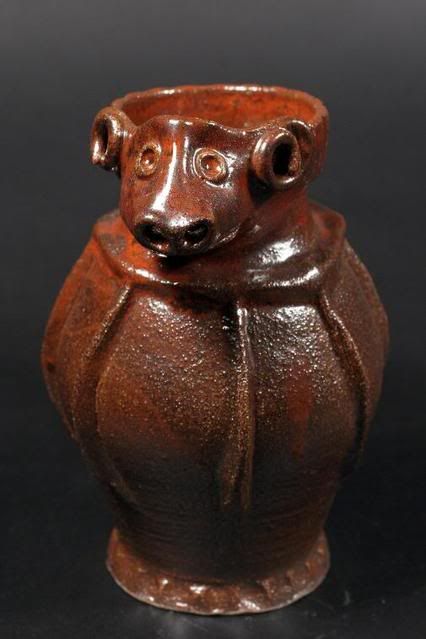
Ram's Head jug.
There are holes in the nostrils so that liquid pours out through them. And yes, this is completely historically correct and disgusting at the same time. Think about Gothic gargoyles on Churches and you have the same principle. Jugs with mouths open, pitchers holding water in the form of animals called Aquamaniles, were used throughout the Middle Ages.
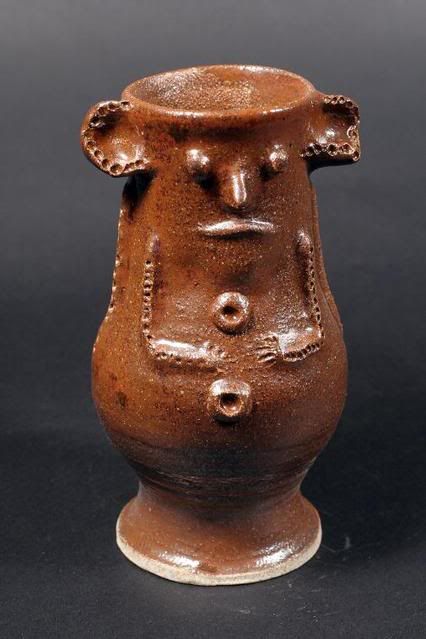
Gentleman Jug... heh.
I originally was going to name him man jug, but that sounded wrong. I don't know what he was called. I only have a cut out picture of him. I do believe he might have been a soldier, but this is a guess. There is a lot of clay manipulation on him, both attaching parts and pushing out to sculpt out his chin and cheeks.
These are just my more recent ones.
Here are some 13th-14th century English examples of jugs that have anthropomorphic and human qualities to them.

Ram's Head jug.
There are holes in the nostrils so that liquid pours out through them. And yes, this is completely historically correct and disgusting at the same time. Think about Gothic gargoyles on Churches and you have the same principle. Jugs with mouths open, pitchers holding water in the form of animals called Aquamaniles, were used throughout the Middle Ages.

Gentleman Jug... heh.
I originally was going to name him man jug, but that sounded wrong. I don't know what he was called. I only have a cut out picture of him. I do believe he might have been a soldier, but this is a guess. There is a lot of clay manipulation on him, both attaching parts and pushing out to sculpt out his chin and cheeks.
These are just my more recent ones.
Labels: anthropomorphic, aquamaniles, english, history, jug, jugs, man, mug, mugs, pitcher, ram, ramshead
Raeren & German Pots
The Museum of London has an enormous collection online of their ceramic pieces, which is very cool when one is trying to recreate the past. I used to buy books (well, still do) whenever I could with whatever information (good or bad) on pottery from all time periods. Because the Museum of London has such a wonderful collection, I now am far more picky with what I need to purchase (which helps my wallet, let me tell you).
Between 1200 and 1600 there was a huge boom in Germany and their pottery production. They had come across salt firings, which was a big advancement. Salt fires at medium to high temperatures, and for a Medieval European Society, firing above earthenware temperatures had been a big struggle.
Here are some of my German steins all within the 1300-1600 period. Raeren is technically a small city in Belgium very close to the German border, but it is catagorized under "German" wares, per Museum of London.
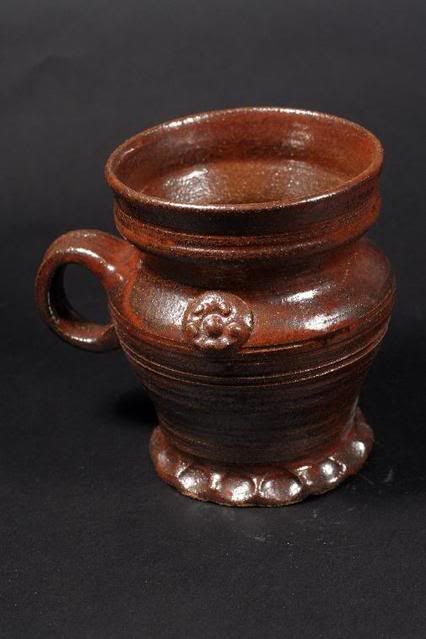
Sprig attached jug, thumbed foot.
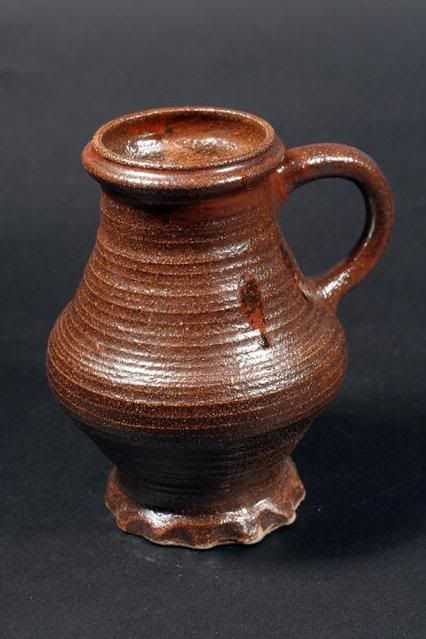
Raeren (Belgium)stoneware biconical drinking mug with thumbed foot, similar to this one off the Museum of London site.
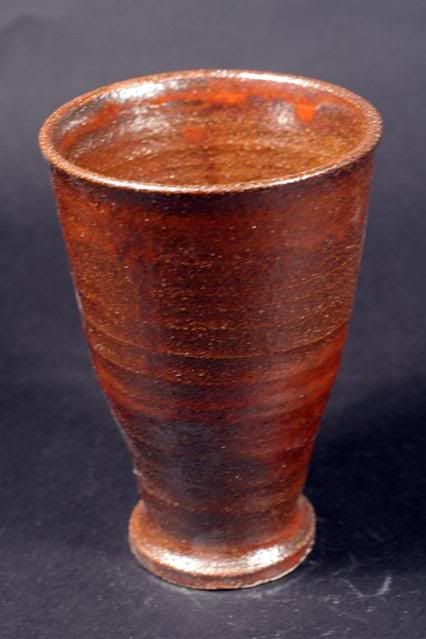
German "becher" or beaker in English. ;)
German forms are very similar to English of the same time period. Germany exported much of their wares, so personally, I have a feeling the English probably copied the Germans, but I haven't really researched this. It is common practice among potters, metalworkers and even glassblowers to copy (or the polite term, "be inspired by) each other's vessels. There are numerous examples of similar beakers in glass and pottery, Aquamaniles in metal and ceramic, and vice versa. Anything to make a buck, right?
Between 1200 and 1600 there was a huge boom in Germany and their pottery production. They had come across salt firings, which was a big advancement. Salt fires at medium to high temperatures, and for a Medieval European Society, firing above earthenware temperatures had been a big struggle.
Here are some of my German steins all within the 1300-1600 period. Raeren is technically a small city in Belgium very close to the German border, but it is catagorized under "German" wares, per Museum of London.

Sprig attached jug, thumbed foot.

Raeren (Belgium)stoneware biconical drinking mug with thumbed foot, similar to this one off the Museum of London site.

German "becher" or beaker in English. ;)
German forms are very similar to English of the same time period. Germany exported much of their wares, so personally, I have a feeling the English probably copied the Germans, but I haven't really researched this. It is common practice among potters, metalworkers and even glassblowers to copy (or the polite term, "be inspired by) each other's vessels. There are numerous examples of similar beakers in glass and pottery, Aquamaniles in metal and ceramic, and vice versa. Anything to make a buck, right?
Labels: belgium, biconical, german, jug, jugs, mold, mug, raeren, sprig
Viking's had to drink too, right?
You knew the Vikings had to drink out of something, right? Well, it's always hard to research this stuff when all the books focus on battles and who is sleeping with whom. Where is the important stuff, like WHAT did they eat or for me, WHAT were they eating out of?
I have a book laying around called "the Vikings," years ago, which had ONE poorly shot picture of these vessels.
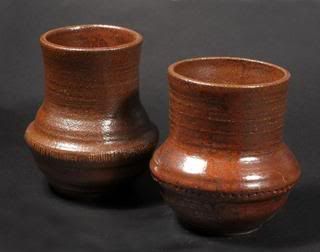

Since then, there are other sites and books that I've come across these same vessels. I make these now as cups and as far as I can tell from this website, they assume it was indeed used for cooking/eating/drink.
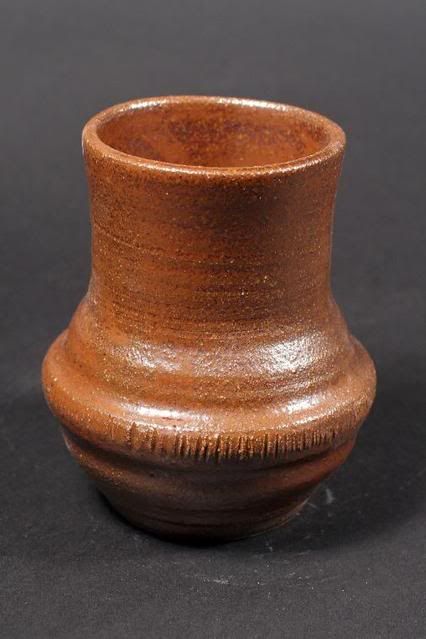
As far as a lot of my reading went, much of the pottery came from the Rhineland, however. Much of the "Viking" cook wear was made of soapstone or traded because in their areas, clay deposits are rare. We can assume that there were some Viking potters, but like with any nomadic tribe that purposefully plagued a great many lands, they traded a lot. And of course, the Vikings left a trail behind. Much of their pottery is found in the UK.
I have a book laying around called "the Vikings," years ago, which had ONE poorly shot picture of these vessels.


Since then, there are other sites and books that I've come across these same vessels. I make these now as cups and as far as I can tell from this website, they assume it was indeed used for cooking/eating/drink.

As far as a lot of my reading went, much of the pottery came from the Rhineland, however. Much of the "Viking" cook wear was made of soapstone or traded because in their areas, clay deposits are rare. We can assume that there were some Viking potters, but like with any nomadic tribe that purposefully plagued a great many lands, they traded a lot. And of course, the Vikings left a trail behind. Much of their pottery is found in the UK.
Labels: beaker, combing, incising, rouletting, thumbing, viking
Wednesday, May 07, 2008
We have new pots! German & English!
I've been busy over the past few months. Mostly I have been updating several English and German forms that I have done in the past, but some of these are variations of forms that were used in the 1400-1600.
Also, I've re-calibrated my fake salt glazes and plan to drop my other glaze that I used to use. I will be tweaking this more for color choices, but I think it really has the texture and coverage now.
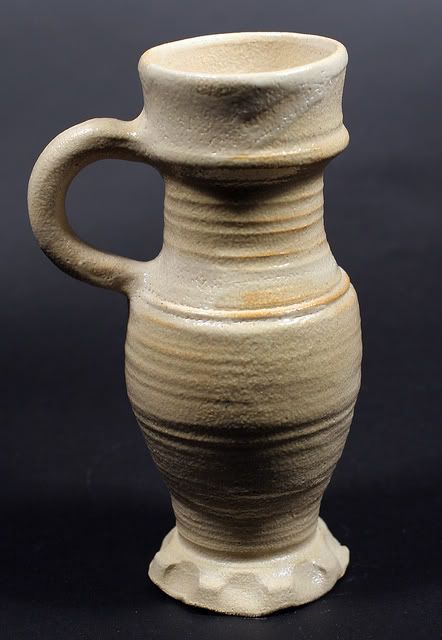
German jug
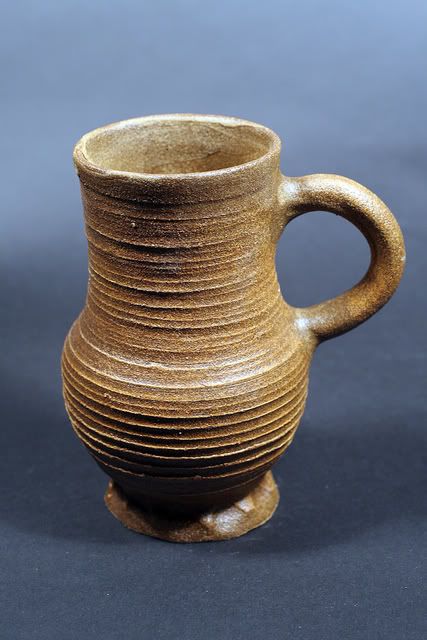
German Jug (different glaze)

German Jug
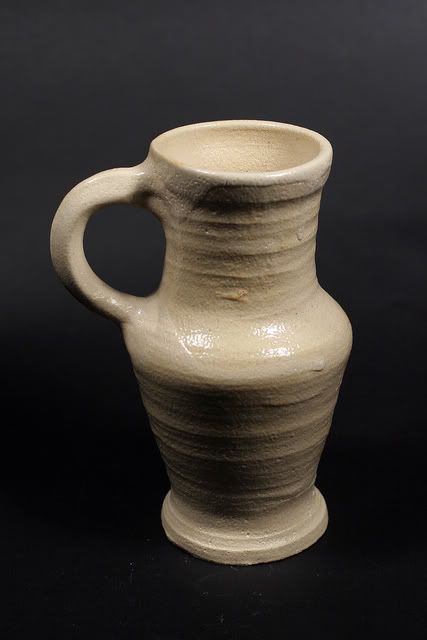
English Jug
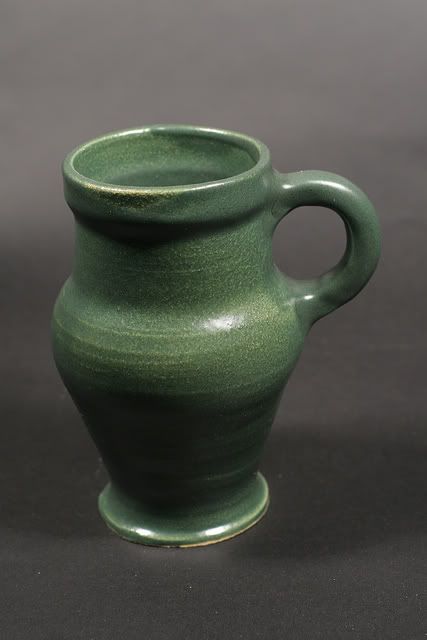
English Jug with my Tudor Green glaze
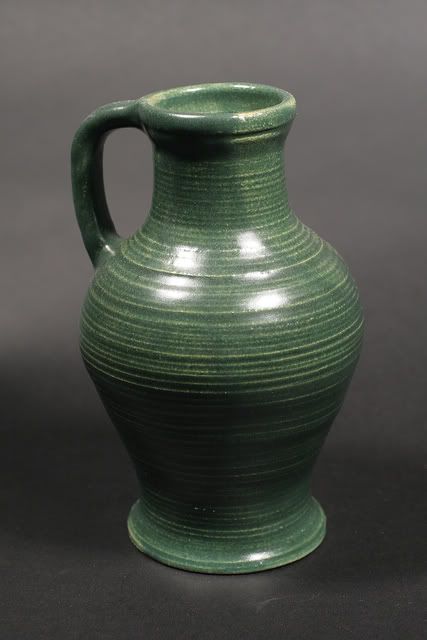
English jug, round belly, with Tudor Green glaze
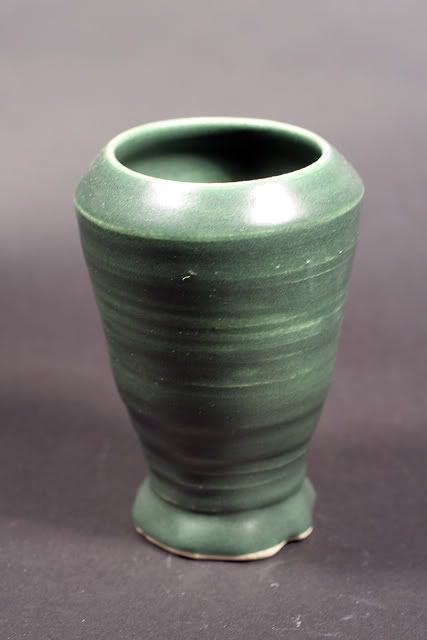
Germann Beaker with Tudor Green glaze
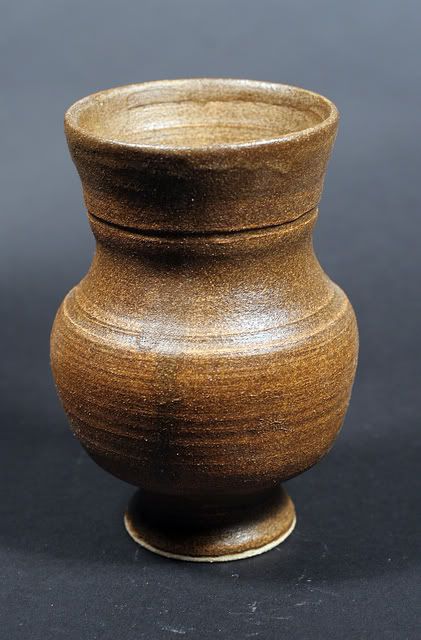
Gaul 5th -6th Century Drinking vessel with fake salt glaze (like second glaze), thrown porcelain
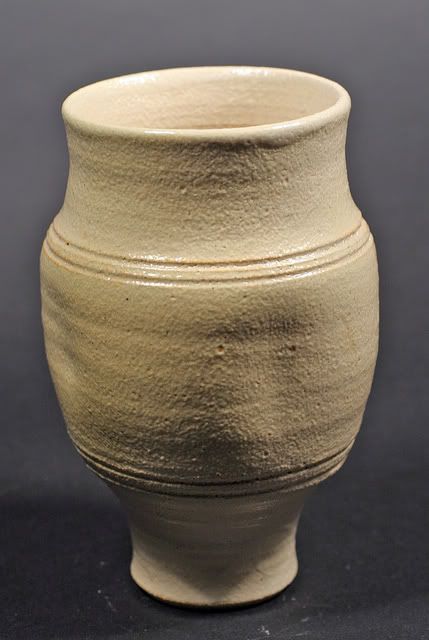
Gaul 5th-6th Century Drinking vessel with fake salt (first glaze)
Most of my work is done on high fire stoneware. All glazes are created by me, the chemistry by me and calibrations, all mine (no computers and I mix everything by hand). Glazes are fired in an electric kiln, which I fire as well.
All forms are researched by me and are accurate historically to the Museum of London site as well as several books.
Just trying to figure out better recreations in order to give the pieces to the Kingdom and Barony.
Also, I've re-calibrated my fake salt glazes and plan to drop my other glaze that I used to use. I will be tweaking this more for color choices, but I think it really has the texture and coverage now.

German jug

German Jug (different glaze)

German Jug

English Jug

English Jug with my Tudor Green glaze

English jug, round belly, with Tudor Green glaze

Germann Beaker with Tudor Green glaze

Gaul 5th -6th Century Drinking vessel with fake salt glaze (like second glaze), thrown porcelain

Gaul 5th-6th Century Drinking vessel with fake salt (first glaze)
Most of my work is done on high fire stoneware. All glazes are created by me, the chemistry by me and calibrations, all mine (no computers and I mix everything by hand). Glazes are fired in an electric kiln, which I fire as well.
All forms are researched by me and are accurate historically to the Museum of London site as well as several books.
Just trying to figure out better recreations in order to give the pieces to the Kingdom and Barony.





